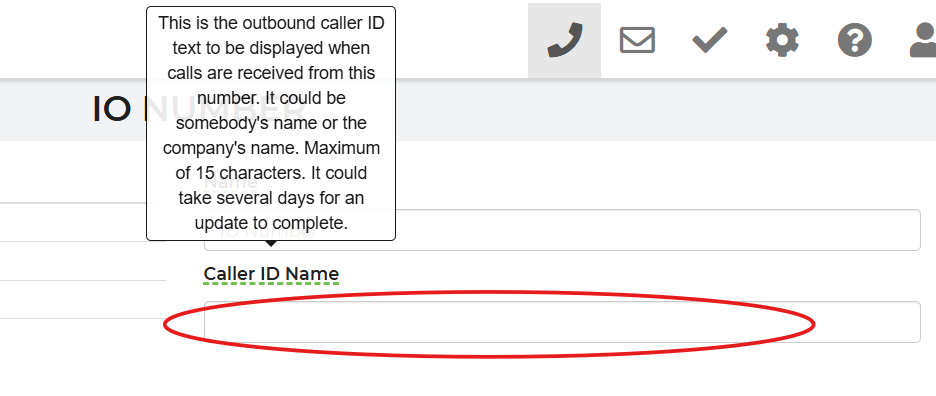Setting a caller ID on your IO Phone number will enhance call recipient trust and professionalism , improve your overall call-back rates and reduce missed opportunities, and streamline your communication process by providing immediate context for your calls.
To add a Caller ID name to your number, go to Settings-->IO Phone-->Numbers. There is a 15 character maximum limit.

How the caller ID name is determined by the recipient carrier:
The Caller ID, 15-character string they set on their numbers registers it through the LIDB (Line Information Database) which, among other things, stores the Caller ID Name (CNAM), which is the display name on landlines (and some mobile devices.)
When a call is received, the receiving carrier (not our vendor, Bandwidth) typically performs a CNAM dip into the LIDB to fetch the 15-character name string (Caller ID) associated with the calling number.
Here’s how the flow works:
- The customer initiates a call with the user’s IO Phone Number + LIDB CNAM entry (ex: “ABC Rentals”)
- The call is routed to the recipient’s carrier
- The receiving carrier decides where to retrieve CNAM:
- First, check its own internal CNAM records (cached)
- If not found or outdated → perform a LIDB dip
- The recipient’s carrier returns the name to the receiving device for display
Note: The originating provider sets CNAM in LIDB, but the receiving carrier controls whether and how that name is displayed
--
Why CNAM Results May Vary
Even if Bandwidth sets a correct CNAM value, the recipient may see:
|
Displayed As |
Reason |
|---|---|
| Correct Name | Carrier performed a fresh LIDB dip |
| “Wireless Caller” / “Spam Risk” | Mobile carriers override based on analytics |
| Old or incorrect name | Cached CNAM entry (carriers often cache 3–30 days) |
| Just the number | Carrier does not use external CNAM at all |
--Mobile Networks vs. Landlines
|
Device Type |
Likelihood of Showing LIDB Name |
Behavior |
|---|---|---|
| Traditional Landline | High | Most reliable LIDB usage |
| Mobile Phones | Medium-Low | CNAM often ignored in favor of analytics caller IDs |
Mobile carriers (Verizon, AT&T Mobility, T-Mobile) increasingly rely on:
- Local device address book
- CNAM-replacement analytics (Hiya/First Orion)
- STIR/SHAKEN attestation levels
- Spam reputation engines
So LIDB does not always equate to branding guarantee on mobile devices
--
Limitations of LIDB
|
Issue |
Cause |
|---|---|
| Mobile carrier overrides | Spam detection > branding value |
| Cache inconsistency | Carriers stale-dip for cost savings |
| Cost of LIDB dips | Carriers reduce dips to save micro-charges |
Bandwidth can only publish, they cannot force display
--
Best Practices for Highest Effectiveness
- Keep CNAM concise and recognizable
- Maintain positive call reputation
• Use high attestation (STIR/SHAKEN A if possible)
• Avoid high-volume short-duration pattern - Consistent usage
• Regular call volumes help establish legitimacy
LIDB is necessary but not sufficient for modern Caller ID branding — it must be paired with reputation management and STIR/SHAKEN compliance.


